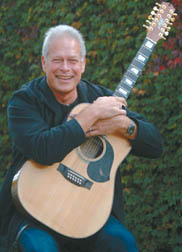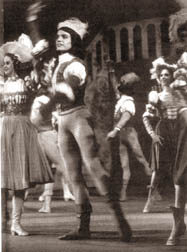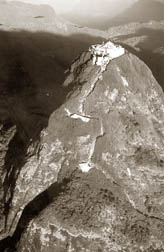|
DAILY NEWS ONLINE |
|
|
|
OTHER EDITIONS |
|
|
|
|
|
|
|
|
|
OTHER LINKS |
|
|
|
|
|
|
  |
|
|
|
|
Taming of the Shrew is a play to have been written earlier and published in 1594 that prompted Shakespeare to re-write it under the same title and made into a broad comedy which can be termed as a more corrupt, pirated version of the original version.
Since this play has an Induction, many directors opt to drop it and move on to the play itself. But those who recognise the Induction, make way in the last scene for sly to wake up outside the tavern to plan and experiment on his own wife what the shrew went through to become an obedient wife.
So, here we have two major parts in the play. First the Induction where Christopher Sly, the drunken tinker, his retinue, a page who pose as his 'wife' imagine himself in transient luxury and tells a nobleman and his hunting party that he had been dreaming for 15 years. This scene fades off at a tavern site. The second part of the play which is the tale of taming an impossible wench until she submits herself to her husband and turn a new leaf.
The story, though simple, is complicating running haywire in different directions until the Bard puts things together at the end. The opening scene could have been set in Warwickshire but the real play has an Italian setting, especially Padua. The tale is about a marriage and consequent taming of Katherina.
She is the elder daughter of a wealthy Paduan citizen of Pisa whom no one wants to marry, opting for her younger sister Bianca. But the custom in Padua is that the elder girl marry before the younger one is considerd. This worries Baptista until a swaggering adventurer from Verona called Petruchio appears in search of a rich wife.; Amidst excitement, the Petruchio / Kath story unfolds;
Baptista:
'You're welcome sir, and he, for your good sake
But for my daughter, Katherene, this I know
She is not for your turn, the more my grief;
Petruchio:
'I see, you do not mean to part with her
Or else you like not of my company?
Baptista:
Mistake me not, I speak but as I find
Whence are you? sir; what may I call your name
Petruchio:
Petruchio is my name. Antonio's son,
A man well known throughout Italy.
Baptista:
I know him well; You are welcome for his sake'
Act. II Scene I
With determination, Petruchio reaches a wedding day after the first angry meeting with Kath who
obviously had overcome;
Katherina:
'Gentlemen, forward to the bridal dinner
I see a woman may be made a fool. If she had not a spirit to resist
Petruchio:
'They shall go forward Kath, at thy command
Obey the bride, you that attend on her
Carouse full measure to her maidenhead
Be mad and marry, or go hang thyselves
But for my bounty, Kath, she must with me
Na, look not big, nor stamp, no stare, nor fret;
I will be master of what is mine.
She is my goods, my chattels; she is my house'....
ACT. III Scene. II
Thus he takes his bride, Kath home dressed in absurdity deliberately against her protests to his home in Verona. Petruchio contrives to keep his wife half-starved, sleepless and frustrated until she yields to his commands. In desperation, Kathe gives in and with time reveals herself in the role of a good wife.
Though Kathe's change is severely tested on the homeward journey to Padua, the plot is resolved when at the wedding feast of her sister Bianca and Lucentio (who had been married secretly), Kath lectures Bianca and another bride on the total duty of a wife as she is to the astonishment of all. The first attempt on stage was by a few comedians in 1667 on very low presentation which could have been called vulgar at that time. David's Garrick's three-act abbreviation Catherine and Petrachio in 1754 which did away with the Induction and Bianca's wooing having a longer life.
The possible return of Shakespeare's text was in 1884 when the play was mounted at Haymarket in neo-elizabethan fashion by Benjamin Webster and J.R. Pinche that astonished everyone of the era. There was also a staging by Stratford in the same year where the Shrew wearing a rose coloured gown stood with upheld head and folded arms in defiance. It was said of her later by a critic 'Here is a girl with a fiery and unbridled temper...wrought to this pitch by uncongenial surroundings. She is a woman worth taming'
Thereafter, the play was seen over and over again in London and at Stratford. Laurence Olivier swooped through Kath when he was still a 14-year-old choirboy from All Saints. Edith Evans (1925) at the Old Vic was a torando as Kath.
Yet another memorable Kath was played by Margaret Street in 1922. The play reached a modern dressing after 1937 when it was revived at the West End. So, the Taming of the Shrew continued and stretched out to other countries which had their own version mounted, filmed and danced. One worth mentioning is Kiss Me Kath in New York in 1948 and in London in 1951.
With scores and lyrics by Cole Porter echoed a musical Shakespearean version. Most recently a version by the Royal Shakespeare Centre featuring Paul Jones was mounted at the Old Vic in 1987. There was also a very successful BBC film directed by Jonathan Miller featuring John Cless and Sara Badel as Petruchio and Kath.
There was also Mary Pickford and Douglas Fairbanks whirling around these characters but none could have matched the 1966 version featuring Richard Burton and Elizabeth Taylor though with a lop-sided text.
Ballet world too found The Taming of the Shrew fascinating. One ballet had two acts choreographed by John Cranko to the scored of Scarlatti-Solze in 1969. Stutgart Ballet mounted it with Martha Haydee as Kath. A very rough version of the plot was revived in 1976 for the Munich State Opera Ballet and for the Royal Ballet in 1977.
The history and legend of Adam's Peak
|
|
The Adam's Peak season has begun and it is quite interesting to delve into the history and legend of this holy mountain which has become a part and parcel of the religious and cultural life of Sri Lanka from time immemorial.
Adam's Peak is situated in the middle of the central hills and four main rivers of Sri Lanka rise in the shade of its thick forests while the ancient gem bearing city of Ratnapura nestles sleepily at its foot. This cone shaped peak is visible from many parts of the island and its prominent landmark is distinctly visible from the Indian ocean.
Many foreign writers have written eloquently about this holy peak. "The peak must be one of the vastest and most revered cathedrals of the human race... The literature of 2,000 years in several languages would have to be searched if all references to it were to be assembled," wrote John Still and Harry Williams wrote: "Adam's Peak is the most sacred mountain in the world under whose spell anger is unknown and even the harlots, who have never known what it is to refuse themselves, do so once the holy fame has been sighted."
W.S. Senior, writing about Adam's Peak says; "It dominates the whole southern half of the island. It is clear from Colombo. From the harbour. From the shop-pavements of Chatham Street. From the lake-spill on the Galle Face. From the grand-stand of the racecourse, dramatic, soaring crown of a dream blue distant range, rising straight from the universal green of the vast intervening plane."
Adam's Peak had been of immense use to mariners from the earliest times and tradition has it that prince Vijaya and his followers were guided to these shores by this landmark. To many people this holy mountain is known by many names.
To the Sinhalese it is Sri Pada (the holy foot-print) or Samanalakanda (The abode of God Saman). To the Hindus it is Swargarohanam (the ascent of heaven). The Maha vamsa refers to it as the Sumanakuta mountain and the early Chinese knew it as Mount Lanka.
Soleyman refers to it as Al Rohan. For many centuries both king and commoner held this mountain in great reverence and Buddhism links it with Buddha's visits to this country. Traditionally it is referred to as the place where Vijaya's banished children found sanctuary. In the 2nd century, during the reign of king Duttagamini, it had been an abode of monks and it had been an accustomed place of worship during the reign of Vijayabahu I.
Senerat Paranavitana, in his monumental work, 'God of Adam's Peak' says: "No inscription referring to the worship of the Foot-print has been found earlier than the 11th century, on the mountain or its vicinity, or anywhere else in Sri Lanka.
The first mention of the Foot-print comes in the reign, when Vijaya Bahu, having seen the difficulties undergone by pilgrims dedicated the village of Gilimalaya to their needs." Stone inscriptions bear ample evidence to these.
Parakrama Bahu II too dedicated much land to Adam's Peak and this king is believed to have fastened iron chains to make the ascent of the peak easier. Later a king of Kandy is said to have provided many stone steps for the convenience of pilgrims. Sitavaka Rajasinghe and king Kirti Sri Rajasinghe had placed specially appointed priests to carry out the religious ceremonies at Adam's Peak.
Early travellers to this island were greatly fascinated by the sacred Foot-print. A 7th century Chinese pilgrim who made the hazardous ascent of the peak says: "When at last I reached the foot of the mountain, I found the country wild, inhabited by wild beasts and extraordinarily rich in precious stones.
After a long waiting I was able to climb to the summit and contemplate the impression of Buddha's foot".
Marco Polo, the well known Venetian traveller wrote: "In this island of Zeilan (Ceylon) there is a very high mountain, so rocky and precipitous that the ascent to the top is impracticable, as it is said, excepting by the assistance of iron chains employed for that purpose.
By means of these some people attain the summit, where the tomb of Adam, our first parent, is reported to be found." In 1344 Ibn Batuta visited Sri Lanka with the main desire of worshipping the peak and Cambodian and Thai Bhikkus referred to Adam's Peak as 'the jewelled crown of the island of Lanka." Writers of more recent times - Knox, Tennent, Hennessey, Still and Williams have written much about Adam's Peak while Senerath Paranavithana's scholarly monograph The God of Adam's Peak, is undoubtedly the best.
There is a strong belief among the villagers that the more perilous climb from the Ratnapura side is more meritorious. Legend has it that Alexander the Great, after the conquest of Northern India, climbed Adam's Peak and fastened iron chains to assist the climbers.
Marco Polo and Ibn Batuta who followed Alexander too have commented on these chains. John Still in his Jungke Tide (page 25) narrates how a whole group of pilgrims went spinning down to the tree tops far below when a chain they were handing on to gave way.
It is very interesting that Adam's Peak is held in the greatest veneration by all four major religions of the world. To the Buddhists the Foot-Print is that of the Buddha. To the Hndus it is Lord Siva's. To the Christians it is that of St. Thomas' and to the Muslims it is that of Adam. Thus Adam's Peak is universally accepted as a holy place of veneration and it has religion and a nation's culture mingled in it.
Keith's last show
 The final performance of Keith Potger of The Seekers will be held at
Galadari Hotel's Gatsby's on January 7. Keith Potger's musical career
started well before The Seekers first stormed the UK charts in 1965 with
Tom Springfield's 'I'll Never Find Another You'.
The final performance of Keith Potger of The Seekers will be held at
Galadari Hotel's Gatsby's on January 7. Keith Potger's musical career
started well before The Seekers first stormed the UK charts in 1965 with
Tom Springfield's 'I'll Never Find Another You'.
He was a self-taught musician, playing the banjo, 12 string guitar and recorder, and with an eye to a musical future, he performed in two groups, The Trinamics and The Escorts.
The Escorts were a fore-runner of The Seekers, and consisted of Keith, Athol Guy, Ken Ray and Bob Turnbull. When Bob Turnbull was replaced by Bruce Woodley, and when Judith Durham joined, replacing Ken Ray, the group became The Seekers.
At first they all had day jobs. Keith was a radio producer for the ABC which meant he had access to a recording studio. When they could find the time, and the studio was free, the newly-formed Seekers laid down some demo tapes (released years later as The Seekers' Golden Collection.) In the evenings they performed at a Melbourne coffee lounge, The Treble Clef, now no longer in existence but famed as the place that gave birth to a world-famous band.
|
|



